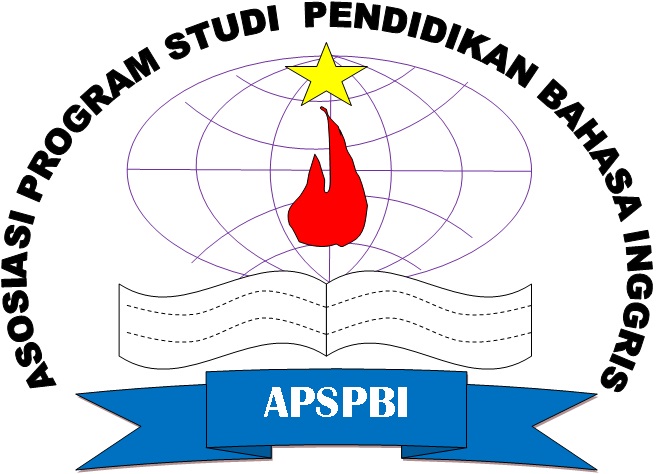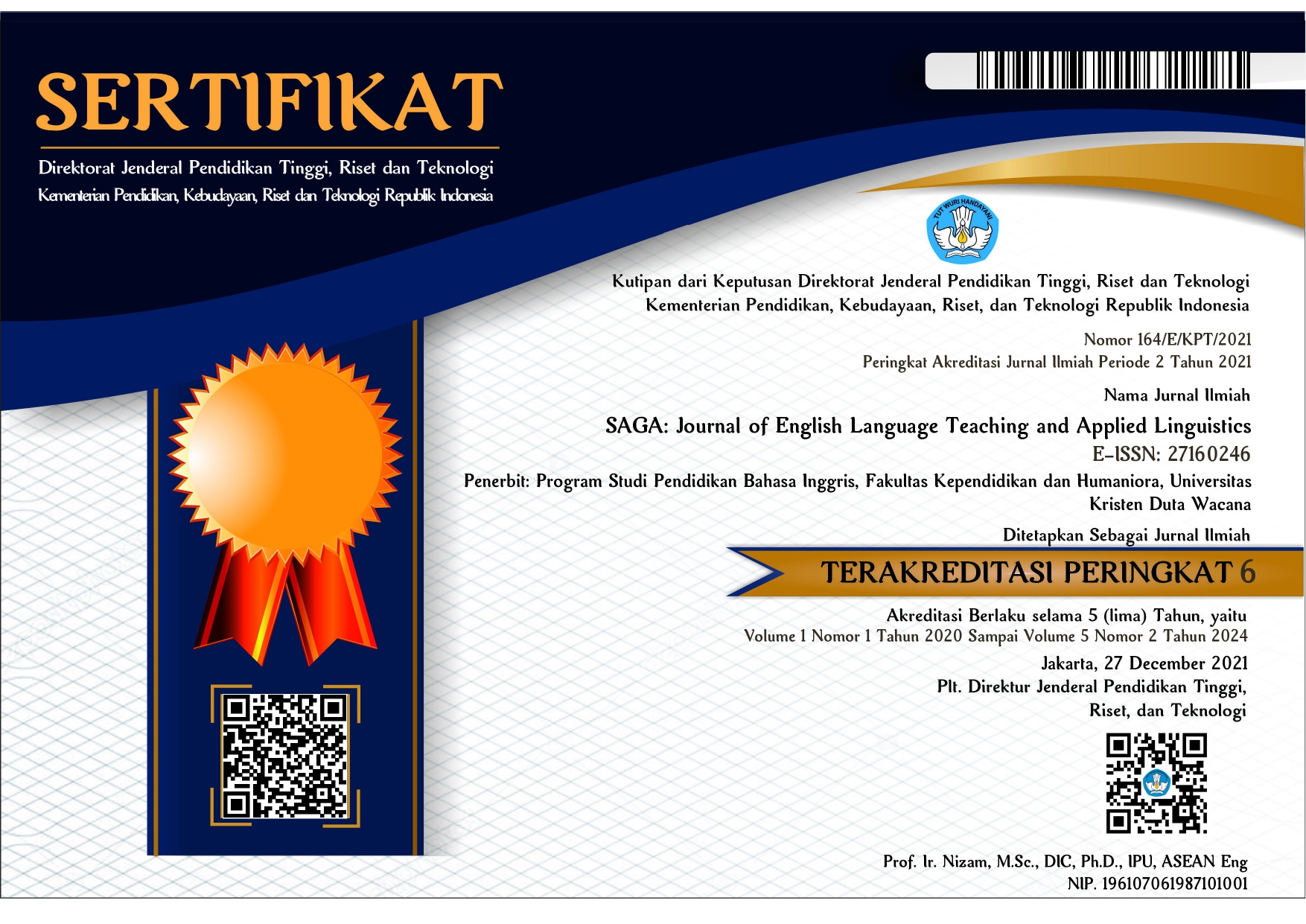ENGLISH LANGUAGE EDUCATION PROGRAM SECOND-YEAR STUDENTS’ SPEAKING DIFFICULTIES IN AN ACADEMIC SPEAKING CLASS
DOI:
https://doi.org/10.21460/saga.2021.22.77Keywords:
Academic Speaking, speaking difficulties, factors, second-year studentsAbstract
Academic Speaking class is the last speaking class that students at an English Language Education Program (ELEP) have to take. However, to pass this class is not very easy because the students had to be able to speak in an academic context. Seeing this phenomenon, the researchers tried to identify the second-year students’ difficulties in the Academic Speaking class, in a private university in Central Java. There are three research questions in this research, “What are ELEP second-year students’ speaking difficulties in Academic Speaking class?”, “What factors contribute to the speaking difficulties in Academic Speaking class?’, and What strategies do the Academic Speaking students employ to overcome the difficulties?”. This research used both qualitative and quantitative approaches that took place at an ELEP and involved 38 participants from three Academic Speaking classes. The data were taken using questionnaires and interviews. This study acknowledged 8 difficulties in speaking English, difficulties in dealing with anxiety, over-using mother tongue, giving a spontaneous response, learning unfamiliar and strange accents, expressing ideas, finding the right lexicon, ordering the right grammatical patterns, and dealing with a competitive environment. Subsequently, the factors which contributed to the difficulties were students’ lack of confidence and lack of vocabulary. The findings of the study are hoped to be advantageous for both students and teachers in the Academic Speaking class.
References
Al- Eiadeh, Al. Sobh, Al-Zoubi & Al-Khasawneh. (2016). Improving English language speaking skills of Ajloun National University students. International Journal of English and Education, 5(3), 181-194. Retrieved from https://www.researchgate.net/publication/306079718_Improving_English_Language_Speaking_Skills_of_Ajloun_National_University_Students
Acharya, B. (2010). Questionnaire design: A working paper. Tribhuvan University. Retrieved from https://www.yumpu.com/en/document/view/39456293/questionnaire-design-the-backbone-of-reseach-saciwaters
Adib, Q. (2010). Grammatical error analysis of speaking of english department students (a study at 2010 speaking class of ELT department of IAIN Walisongo). A thesis. Walisongo State Institute for Islamic Studies Semarang. Retrieved from http://library.walisongo.ac.id/digilib/files/disk1/140/jtptiain--qowimuladi-6955-1-qowimul-5.pdf
Al Hosni, S. (2014). Speaking difficulties encountered by young EFL learners. IJSELL, 2(6), 22-30. Retrieved from https://www.researchgate.net/publication/270340628_Speaking_Difficulties_Encountered_by_Young_EFL_Learners
Burkart, G.S. (1998). “Spoken language: What it is and how to teach it”. Washington, DC: Center for Applied Linguistics. Retrieved from
https://files.eric.ed.gov/fulltext/ED433722.pd
Chang, Y.-P. (2010). A study of EFL college students’ self-handicapping and English performance. Procedia – Social and Behavioral Sciences, 2(2), 2006-2010. Retrieved from https://www.researchgate.net/publication/232415396_A_Study_of_EFL_college_students'_self-handicapping_and_English_performance
Dewaele, J.M., & McCloskey, J. (2014). Attitudes towards foreign accents among adult multilingual users. Journal of Multilingual and Multicultrual Development, 36(3). Retrieved from https://www.researchgate.net/publication/262260218_Attitudes_towards_Foreign_accents_among_adult_multilingual_language_users
Dewi, M.F. (2013). Communication strategies used by Transactional Speaking students in English Department of Satya Wacana Christian University. Retrieved from https://repository.uksw.edu/bitstream/123456789/7316/2/T1_112009132_Full%20text.pdf
Fitriani, D.A., Apriliaswati & Wardah, R.A. (2015). A study on student’s English speaking problems in speaking performance. Jurnal Pendidikan dan Pembelajaran Khatulistiwa, 4(9), 1-13. Retrieved from https://jurnal.untan.ac.id/index.php/jpdpb/article/view/11345/10753
Freeman, D. L. (2001). Teaching language: From grammar to grammaring. Boston: Heinle.
Gardner, R. C. (1985). Social psychology and second language learning: The role of attitudes and motivation. London: Edward Arnold.
Harahap, S. S., Antoni, R. & Rasyidah, U. (2015). An analysis on students’ speaking skill at second grade SMP 8 Rambah Hilir. A study. University of Pasir Pengaraian. Retrieved from https://e-journal.upp.ac.id/index.php/binggrisfkip/article/view/310
Karademir, M. (2016). Speaking problems in EFL classes graduation thesis. A thesis. Karadeniz Technical University, 1-31. Retrieved from
Kumaravadivelu, B. (2003). Beyond methods. London: Yale University Press. Retrieved from
http://www.ugr.es/~isanz/archivos_m3thodology/kumaravidelulibrocap1.pdf
Leong, L-M & Ahmadi, M.S. (2017). An analysis of factors influencing learners’ English speaking skills. International Journal of Research in English Education, 34-41.
doi: 10.18869/acadpub.ijree.2.1.34
Littlewood, W. & Yu, B. (2011). First language and target language in the foreign language classroom. Language Teaching, 44(01), 64-77. http://dx.doi.org/10.1017/s0261444809990310
Malihah, N. (2010). The effectiveness of speaking instruction through task-based language teaching. Register Journal, 3(1), 85-101. Retrieved from
https://journalregister.iainsalatiga.ac.id/index.php/register/article/view/1152/750
Masdayasna, G. (2012). Objective assessment of oral presentation and EFL learners’ speaking development. Sheikhbahaee EFL Journal,1(1), 23-38. Retrieved from http://efl.shbu.ac.ir/article_79159.html
Nation, I. S. P. (2008). Learning vocabulary in another language. Cambridge: Cambridge University Press.
Ni, Hui. (2012). The Effects of Affective Factors in SLA and Pedagogical Implications. Theory and Practice in Language Studies, 2(7), 1508-1513. Retrieved January 23, 2014 from http://www.academypublication.com/issues/past/tpls/vol02/07/25.pdf
Novitasari, N. F. (2019). Collaborative Learning in ESP Speaking Classroom: Learners’ Perceptions and Experiences. University of Abdurachman Saleh Situbondo. SoLEC International Seminar on Language, Education, and Culture, Volume 2019.
Nunan, D. 1991 Language teaching methodology: A textbook for teachers. New York: Prentice Hall International, Ltd. Retrieved from: https://archive.org/details/ilhem_20150321_1903
Núñez, K. & Daniel, K. (2018). Environmental factors affecting the English proficiency of students of EFL in the extracurricular courses at UASD. A thesis. Universidad Autónoma De Santo Domingo. Retrieved from https://files.eric.ed.gov/fulltext/ED593996.pdf
Nuraini, K. (2016). The barriers of teaching speaking English for EFL learners. Ellite Journal, 1(1). Retrieved from http://jurnal.unmuhjember.ac.id/index.php/ELLITE/article/viewFile/159/96
Öztürk, G. & Gürbüz, N. (2014). Speaking anxiety among Turkish EFL learners: The case at a state university. Journal of Language and Linguistic Studies, 10(1), 1-17. Retrieved from https://www.researchgate.net/publication/292991923_Speaking_anxiety_among_Turkish_EFL_learners_The_case_at_a_state_university
Phuangmanee, N. (2016). Problems in English language communication perceived by salespeople at a telecommunication company in Bangkok, Thailand. Retrieved from http://ethesisarchive.library.tu.ac.th/thesis/2016/TU_2016_5821040267_6960_4813.pdf
Rohmatillah. (2014). A study on students’ difficulties in learning vocabulary. English Education Journal Tadris Bahasa Inggris, 6(1) 69-86. Retrieved from http://ejournal.radenintan.ac.id/index.php/ENGEDU/article/view/520/345
Sayuri. (2016). English speaking problems of EFL learners of Mulawarman University. Nabil Husein College, Indonesia. Indonesian Journal of EFL and Linguistics, 1(1). Retrieved from http://www.indonesian-efl-journal.org/index.php/ijefll/article/download/4/pdf
Scrivener, J. (1994). Learning teaching. Oxford: Macmillan. Retrieved from https://jonturnerhct.files.wordpress.com/2015/08/learning-teaching-by-james-scrivener.pd
Tanveer, M. (2007). Investigation of the factors that cause language anxiety for ESL/EFL learners in learning speaking skills and the influence it casts on communication in the target language. A Master’s thesis. University of Glasgow, England. Retrieved from http://www.asian-efl-journal.com/thesis_M_Tanveer.pdf.
Taqiyuddin. (2011). The teachers’ techniques in improving students pronouncing words loudly at the first year of MAN Batam. Retrieved from http://repository.uin-suska.ac.id/290/1/2011_2011495-.pdf
Widodo, H. P. (2015). The development of vocational English materials from a social semiotic perspective: Participatory action research. (A Doctoral dissertation) University of Adelaide, Australia. Retrieved from https://digital.library.adelaide.edu.au/dspace/bitstream/2440/97910/2/02whole.pdf
Yumniamatillah, F. (2017). Difficulties in speaking English among the first year students of English education department of Universitas Muhammadiyah Yogyakarta. A thesis. Universitas Muhammadiyah Yogyakarta (UMY). Retrieved from http://repository.umy.ac.id/bitstream/handle/123456789/16945/11.%20Naskah%20Publikasi.pdf?sequence=12&isAllowed=y
Zhang. S. (2009). The role of input, interaction and output in the development of oral fluency. English Language Teaching, 2(4). Retrieved from https://www.researchgate.net/publication/42386406_The_Role_of_Input_Interaction_and_Output_in_the_Development_of_Oral_Fluency
















